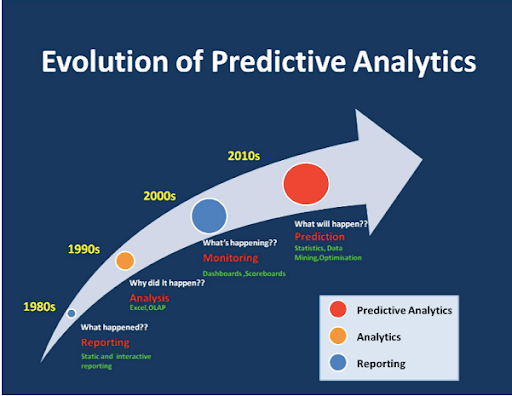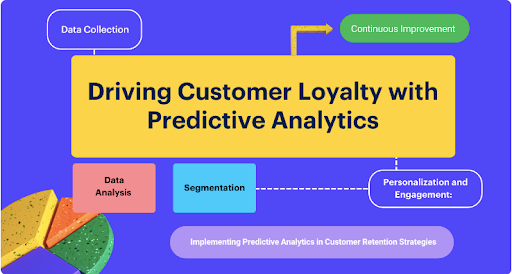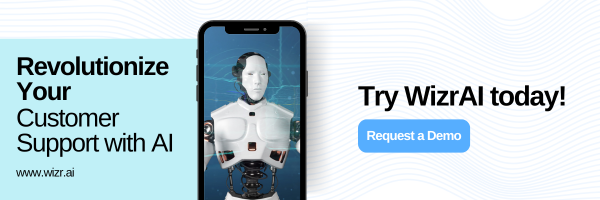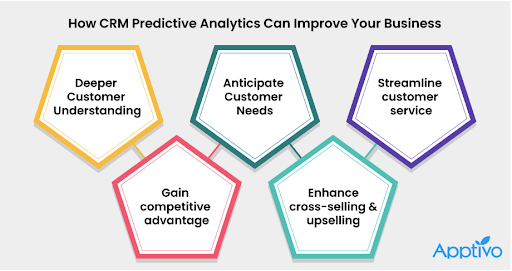In today’s competitive business landscape, delivering exceptional customer service has become more crucial than ever. With consumers having a myriad of options at their fingertips, companies must find innovative ways to stand out and cater to their customers’ ever-evolving needs.
This is where the power of predictive analytics in customer service comes into play. By harnessing the vast amount of data available, businesses can gain valuable insights into customer behavior, preferences, and potential issues, allowing them to predict and proactively address customer needs through predictive customer analytics.

In this blog post, we will delve into the transformative impact of predictive analytics on customer experience, exploring the immense benefits it brings to businesses and the strategies they can adopt to leverage this powerful tool effectively. Whether you are a small business owner or a customer service manager, understanding and harnessing the power of predictive analytics customer experience will undoubtedly enhance your ability to exceed customer expectations and drive sustainable growth.
What is Predictive Analytics in Customer Service?

Predictive analytics in customer service is an advanced data analysis technique that involves extracting meaningful insights from past data to predict what is likely to happen in the future. In various industries, including customer service, predictive analytics plays a crucial role in anticipating and understanding patterns, enabling businesses to make informed decisions and take proactive measures. By analyzing vast datasets, businesses can identify potential trends, behaviors, and outcomes, ultimately helping them optimize processes, enhance decision-making, and improve overall performance. For example, staying informed about customer support trends can provide valuable insights to enhance customer experiences and adapt to changing market demands.
Integrating predictive analytics customer service can significantly enhance a company’s ability to anticipate customer needs, leading to a more efficient and effective customer service strategy.
Why Is Predictive Customer Analytics Important?

Predictive analytics in customer service is a transformative tool that brings a multitude of advantages, positively impacting both businesses and their clientele. In particular, businesses can also explore the advantages of customer service automation to further enhance operational efficiency and customer satisfaction. Let’s delve into the key benefits of predictive customer analytics:
1. Anticipating Customer Needs
Predictive analytics analyzes historical customer data to identify patterns and trends. By understanding past customer interactions, businesses can predict future needs using predictive customer analytics. This enables companies to pre-emptively address customer requirements, offering tailored solutions and services, thereby improving the predictive analytics customer experience.
2. Proactive Issue Resolution
Customer predictive analytics enables businesses to create highly personalized customer experiences. By analyzing customer data, companies can predict individual preferences and tailor their interactions accordingly. This allows for targeted communication, personalized recommendations, and more engaged customers, fostering stronger customer loyalty through effective predictive customer service strategies.
3. Personalizing Customer Interactions
Predictive analytics enables businesses to create highly personalized customer experiences. By analyzing customer data, companies can predict individual preferences. This allows for targeted communication, personalized recommendations, and more engaged customers, fostering stronger customer loyalty.

4. Optimizing Resource Allocation
Predictive analytics helps businesses optimize their resource allocation within customer service operations. By forecasting demand and understanding peak service times, companies can allocate resources efficiently. This results in improved response times, reduced wait periods, and an overall enhancement of the predictive analytics customer experience, showcasing the impact of effective customer predictive analytics.
5. Continuous Improvement
The integration of predictive analytics into customer service is an iterative process. Regularly updating and refining predictive models ensures that businesses stay attuned to evolving customer preferences and market dynamics. This continuous improvement loop is crucial for maintaining the effectiveness of predictive analytics in customer service and enhancing the overall customer predictive analytics strategy.
Data Sources for Predictive Analytics in Customer Care
The effectiveness of predictive analytics customer service relies heavily on the quality and diversity of the data it analyzes. In the realm of customer service, various data sources contribute to the development of accurate predictive models:
- Customer Interaction Data
Analyzing data from customer interactions, such as support tickets, chat logs, and call transcripts, provides valuable insights into customer preferences, issues, and behavior patterns that inform predictive customer analytics.
- Customer Feedback and Surveys
Feedback from customers, whether collected through surveys or online reviews, serves as a rich source of data for understanding customer sentiment and identifying areas for improvement, enhancing predictive analytics customer experience.
- Purchase History and Transaction Data
Examining historical purchase data helps businesses predict future buying behavior and tailor their customer service strategies to meet specific customer needs, making predictive analytics in customer service even more effective.
- Social Media and Online Activity
Monitoring social media platforms and online forums allows businesses to tap into the broader sentiment of their customer base, identifying trends and potential issues before they become widespread, further supporting predictive analytics customer service efforts.
- Demographic and Geographic Data
Understanding the demographics and geographic locations of customers helps in creating targeted customer service strategies, considering regional preferences and cultural nuances, thereby enhancing overall customer predictive analytics.
4 Key Benefits of Predictive Customer Analytics for Enhancing Customer Experience

Predictive analytics in customer service is a transformative tool that brings a multitude of advantages, positively impacting both businesses and their clientele. By tracking and analyzing key customer service metrics, businesses can make informed decisions and enhance customer satisfaction. Let’s delve into the key benefits of predictive customer analytics:
1. Improved Customer Satisfaction
Customer satisfaction is the cornerstone of any successful business. Predictive analytics plays a pivotal role in elevating satisfaction levels by:
- Anticipating Customer Needs: Predictive customer analytics analyzes historical data to foresee customer preferences, enabling businesses to provide personalized services tailored to individual needs.
- Reducing Resolution Times: By proactively identifying potential issues, businesses can address them before customers even notice, leading to quicker resolutions and heightened satisfaction through effective predictive analytics customer service.
- Enhanced Communication: Predictive analytics in customer service allows for targeted and personalized communication, ensuring that customers receive relevant information, promotions, and support, thereby fostering a stronger emotional connection with the brand.
2. Enhanced Personalization
Personalization is the key to creating meaningful and lasting customer relationships. Predictive analytics achieves this by:
- Tailoring Recommendations: Analyzing customer data helps in predicting individual preferences, allowing businesses to offer personalized product recommendations and services through customer predictive analytics.
- Customized Communication: Businesses can craft targeted marketing messages and communication strategies, ensuring that customers receive information that resonates with their specific needs and interests, enhancing predictive customer service.
- Improved Customer Retention: Personalized experiences build customer loyalty. Predictive analytics customer experience helps in predicting churn risks and implementing retention strategies, ensuring a more loyal customer base.
3. Proactive Issue Resolution
Predictive analytics empowers businesses to be ahead of potential problems, leading to:
- Preventing Issues: By analyzing data patterns, businesses can identify and address potential issues before they escalate, minimizing disruptions in customer service.
- Reduced Downtime: Proactive issue resolution means less downtime for customers, resulting in a smoother and more reliable service experience.
- Enhanced Reputation: Quickly addressing issues before they impact customers contributes to a positive brand image, enhancing trust and credibility through effective predictive analytics in customer service.
4. Cost Savings and Efficiency Gains
Operational efficiency and cost-effectiveness are crucial aspects of any business. Predictive analytics achieves this by:
- Optimizing Resource Allocation: Businesses can allocate resources more efficiently by forecasting demand and understanding peak service times, resulting in cost savings and improved efficiency through predictive customer analytics.
- Reducing Wasted Efforts: By focusing efforts on anticipated customer needs and potential issues, businesses avoid wasting resources on reactive measures.
- Streamlining Processes: Predictive analytics customer service can identify inefficiencies in customer service processes, allowing businesses to streamline operations for greater efficiency and cost-effectiveness.
Challenges and Considerations of Predictive Analytics in Customer Service
While predictive customer analytics holds immense potential for revolutionizing customer service, it is not without its challenges. Addressing these concerns is crucial for businesses to fully harness the benefits of customer service automation in order to streamline processes and improve customer interactions. Here are some key challenges and considerations associated with integrating predictive analytics into customer service:
1. Data Privacy and Security
- Customer Privacy Concerns
Predictive analytics customer experience relies heavily on customer data. Ensuring the privacy and security of this information is paramount. Customers are increasingly concerned about how their data is being used. Businesses must implement robust data protection measures to build and maintain trust in their predictive customer service efforts.
- Compliance with Regulations
Various data protection regulations, such as GDPR and CCPA, impose strict guidelines on how customer data is collected, processed, and stored. Adhering to these regulations is not only a legal requirement but also essential for maintaining ethical standards in predictive analytics customer service practices.
- Data Breach Risks
The more data a business collects, the greater the risk of a data breach. Predictive analytics systems must have robust security measures in place to safeguard against unauthorized access. Businesses need to invest in encryption, access controls, and regular security audits to mitigate these risks in their customer predictive analytics strategies.
2. Potential Bias in Predictive Models
- Data Bias and Fairness
Predictive customer analytics models are only as good as the data they are trained on. If historical data contains biases, the predictive models may perpetuate those biases. This can result in unfair treatment of certain customer segments. Regular audits are necessary to identify and rectify any biases in the models to ensure fair predictive analytics in customer service.
- Ethical Considerations
The ethical implications of using predictive analytics in customer service cannot be overlooked. Businesses must prioritize fairness and transparency in their algorithms. Clear communication with customers about how their data is used and ensuring that predictive models do not discriminate are essential ethical considerations in predictive analytics customer experience.
3. Integration Challenges with Existing Systems
- Legacy System Compatibility
Many businesses have legacy systems in place, and integrating predictive analytics with these systems can be challenging. Compatibility issues may arise, leading to delays in implementation. Businesses need a well-thought-out integration strategy to overcome these challenges in their predictive customer service frameworks.
- Skill and Training Gaps
Implementing predictive customer analytics requires a certain level of expertise. Businesses may face challenges in finding skilled professionals capable of handling the complexities of predictive modeling. Providing adequate training to existing staff or hiring skilled personnel becomes crucial for effective predictive analytics customer service.
- Costs and Resource Allocation
The integration of predictive analytics systems often involves substantial upfront costs. Additionally, ongoing maintenance and updates require dedicated resources. Businesses need to carefully assess the financial implications and allocate resources effectively to ensure a smooth integration process into their predictive analytics customer experience strategies.
Best Practices for Implementing Predictive Analytics in Customer Service in 2025
Implementing predictive analytics in customer service requires a thoughtful and strategic approach. To maximize the benefits of this powerful tool, businesses should adopt best practices that ensure accurate insights, seamless collaboration, and ongoing effectiveness. Here are key practices for successful implementation of predictive customer analytics:
1. Robust Data Collection and Management
- Comprehensive Data Gathering
Successful predictive analytics customer experience relies on the availability of comprehensive and high-quality data. Ensure that your data collection processes cover various customer touchpoints, including online interactions, purchase history, and customer feedback.
- Data Quality Assurance
Maintain data accuracy by implementing rigorous quality control measures. Regularly clean and update databases to eliminate inaccuracies and inconsistencies, ensuring that customer predictive analytics models are built on reliable information.
- Integration of Data Sources
Integrate diverse data sources to create a holistic view of customer interactions. Combining data from CRM systems, social media, and other relevant platforms provides a more accurate representation of customer behavior and preferences in predictive analytics customer service.
- Data Security and Privacy
Prioritize the security and privacy of customer data. Implement robust cybersecurity measures and adhere to data protection regulations to build trust with customers and ensure compliance in your predictive customer service initiatives.
2. Cross-functional Collaboration
- Inclusive Team Collaboration
Establish cross-functional teams that bring together data scientists, IT professionals, customer service representatives, and business leaders. Collaboration ensures diverse perspectives and expertise, fostering a holistic approach to implementing predictive analytics in customer service.
- Clear Communication Channels
Facilitate open and transparent communication channels among team members. Clear communication ensures that insights from predictive customer analytics are effectively translated into actionable strategies within the customer service department and across the organization.
- Training and Skill Development
Provide training programs to equip employees with the skills needed to understand and leverage predictive analytics tools. Empowering employees with the knowledge to interpret insights enhances the overall effectiveness of the implementation in predictive analytics customer service.
3. Continuous Monitoring and Evaluation
- Regular Model Audits
Periodically audit and update predictive analytics customer experience models to ensure they remain accurate and relevant. Market dynamics and customer behavior change over time, and regular assessments help maintain the effectiveness of the models.
- Key Performance Indicators (KPIs)
Define and monitor KPIs to assess the impact of predictive analytics in customer service on performance. Metrics such as customer satisfaction scores, resolution times, and service efficiency can provide valuable insights into the success of the implementation.
- Feedback Loop
Establish a feedback loop that involves continuous communication between predictive analytics teams and customer service representatives. Feedback from frontline staff helps refine models, making them more attuned to the evolving needs and challenges faced in customer predictive analytics.
Transforming Predictive Customer Analytics: How Wizr AI Enhances Customer Experience
In today’s fast-paced business environment, predictive analytics in customer service has become a game-changer. Wizr AI leverages advanced AI capabilities to analyze historical data, identify patterns, and forecast customer needs. This enables businesses to deliver exceptional, proactive support while streamlining operations and improving predictive customer experience.
How Wizr AI Helps with Predictive Analytics in Customer Service
1. Proactive Issue Resolution with Predictive Customer Service
Wizr AI anticipates potential problems before they occur, empowering businesses to resolve issues proactively. By analyzing past customer interactions, system data, and behavioral trends, Wizr AI identifies early warning signs and recommends preventive actions.
- Example of Predictive Analytics in Customer Service: A SaaS company uses Wizr AI to detect recurring error patterns in their software and alerts customers with troubleshooting solutions. This significantly reduces service tickets, enhances efficiency, and improves predictive customer satisfaction analytics.
2. Personalized Customer Support with Predictive Customer Analytics
Wizr AI analyzes customer data to deliver highly personalized support experiences. By understanding customer preferences, interaction history, and sentiment, Wizr AI ensures tailored solutions that improve engagement and predictive customer care.
- Example: In e-commerce, Wizr AI sends targeted support messages, such as personalized offers or proactive outreach for abandoned carts, driving conversions and enhancing predictive analytics in customer experience.
3. Optimized Resource Management for Predictive Analytics in Customer Service
Efficient allocation of resources is critical for delivering timely customer service. Wizr AI uses predictive customer analytics to forecast peak demand, helping businesses optimize staffing, reduce response times, and improve service delivery.
- Example: A contact center uses Wizr AI to predict high ticket volumes during seasonal promotions. This ensures enough agents are available to handle the influx, enhancing operational efficiency with predictive customer satisfaction analysis software.
4. Reducing Customer Churn with Predictive Analytics for Customer Retention
By analyzing customer sentiment and behavior, Wizr AI identifies at-risk customers and flags opportunities for retention. Businesses can take timely action to address concerns, reduce churn, and improve predictive analytics customer satisfaction.
- Example: A telecom provider leverages Wizr AI to identify dissatisfied customers based on interaction sentiment. Proactive outreach and tailored solutions prevent churn, driving predictive analytics for customer retention.
5. Intelligent Automation for Routine Tasks Using Predictive Analytics
Wizr AI integrates predictive analytics customer care with automation to efficiently handle routine inquiries. AI-powered chatbots and virtual assistants streamline responses, allowing human agents to focus on complex issues.
- Example: Financial institutions use Wizr AI-powered chatbots to predict common queries about account status and deliver automated resolutions, enhancing efficiency with predictive customer satisfaction analysis software.
6. Enhancing Customer Satisfaction with Sentiment Insights
Wizr AI’s sentiment analysis tools provide deep insights into customer emotions and preferences. By predicting sentiment trends, businesses can proactively adjust strategies to ensure a seamless predictive customer experience.
- Example: An online retailer identifies rising dissatisfaction related to delivery delays. Wizr AI forecasts these issues and triggers proactive communication, boosting trust and enhancing predictive customer satisfaction analytics platform results.
Conclusion
Predictive analytics in customer service empowers businesses to anticipate customer needs, enhance personalization, and streamline operations, ultimately improving customer satisfaction and loyalty. By leveraging predictive customer analytics, businesses can gain deep insights into customer behavior, enabling proactive solutions and better service delivery. Embracing predictive analytics for customer retention and predictive customer satisfaction analysis is not just a competitive advantage; it’s a necessity for businesses focused on shaping the future of predictive customer analytics experiences. With the right tools, companies can drive predictive analytics in customer service to achieve higher operational efficiency and long-term customer satisfaction.
About WizrAI
Wizr AI is an Advanced Enterprise AI Platform that empowers businesses to build Autonomous AI Agents, AI Assistants, and AI Workflows, enhancing enterprise productivity and customer experiences. Our CX Control Room leverages Generative AI to analyze insights, predict escalations, and optimize workflows. CX Agent Assist AI delivers Real-Time Agent Assist, boosting efficiency and resolution speed, while CX AutoSolve AI automates issue resolution with AI-Driven Customer Service Automation. Wizr Enterprise AI Platform enables seamless Enterprise AI Workflow Automation, integrating with data to build, train, and deploy AI agents, assistants, and applications securely and efficiently. It offers pre-built AI Agents for Enterprise across Sales & Marketing, Customer Support, HR, ITSM, domain-specific operations, Document Processing, and Finance.
Experience the future of enterprise productivity—request a demo of Wizr AI today.
